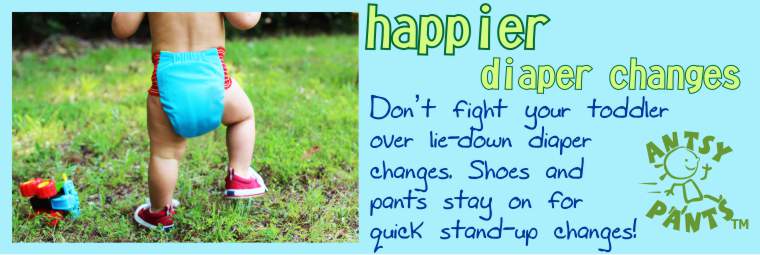 How to Troubleshoot Cloth Diapers to Solve (and Control) Mystery Leaks How to Troubleshoot Cloth Diapers to Solve (and Control) Mystery Leaks
If you've found your way to this page, I assume that you have cloth diapers that are leaking, or you are looking
into cloth diapers and want to be at least reasonably educated on what to do if the issue does come up. I began my
own cloth diaper journey nine years ago when Antsy Pants™ Graduate #1 was born, and had one or two kids in diapers
at least overnight for eight years. My background before that was in technical apparel design with a lot of
technical knowledge of textiles that gave me a lot of insight into how fabrics perform in technical uses.
Here are the five steps I recommend you follow to debug any leaks you may encounter while using any style or
brand of cloth diapers, followed by an explanation of why it matters and what to do about leaks with that probable
cause. Lets get started.
5-Step Troubleshooting Guide for Cloth Diaper Leaks
1. Have the cloth diapers been washed prior to use?
Why? Many brands of cloth diapers, Antsy Pants™ Pull-Up Cloth Diapers included, are made from fabrics with
finishes on them that keep them from absorbing moisture until they have been washed one or more times with
detergent.
What to do: wash your diapers before further use with a good detergent meant for the wash cycle you will use. My
preference over time became liquid detergent such as Tide as the diapers didn't develop a buildup of residue in
them that would reduce their absorbency and cause stinky diapers.
This prewash will remove any finishes and also any shrinkage from fabrics and elastics so your diapers will fit as
intended.
2. Do the cloth diapers fit correctly?
If, after prewashing, the long edges of the diaper should create a close fit around the thigh or, in the case of
Antsy Pants™ Pull-Up Cloth Diapers, to the body near the leg join.
Why? Gapping between then leaks can occur on sleeping or active wearers as gaps form between skin and
diaper.
What to do: check for gapping, indicating a too-large diaper size, or excessively tight elastics that leave dark
red marks on your child's skin after wearing, indicating a too-small diaper size. If your diapers are too large or
too small, check for any adjustable snaps or elastic to correct the sizing (for example, one-size cloth diapers).
In the case of Antsy Pants™ Pull-Up Cloth Diapers, loose or tight waist and rise fit can be corrected with a
no-charge size exchange for replacement diapers within 45 days of your order. Contact us
at for details. Please include your child's height, weight, age, and the size of Antsy
Pants™ purchased, and describe any leaks and whether diapers are too large or too small for your child.
If the cloth diapers are the correct size but you still have leaks after washing to remove any finishes, there
are generally two causes:
3. Are the diaper's absorbent materials fully saturated when leaks occur?
Why? If the absorbancy built into your diapers is becoming super wet and heavy to the point where the diaper is
effectively full past its absorbent capacity, the moisture will seek out somewhere to go, no matter how waterproof
and well-fitting all of its elements are.
What to do: Add more absorbency with a doubler or second insert.
4. Is moisture migrating over time from absorbent layers to other elements of the diaper, especially with
overnight use?
Why? Sometimes cloth diapers incorporate materials that are not intended to absorb moisture, but over time can
pull moisture from the intended absorbent materials to parts of the cloth diaper that should stay dry. From there,
clothing, jammies and bedding can all become wet.
What to do: if moisture pulls into unwanted places over time by way of elastics, side panels, etc., you can very
easily apply a water-resistant finish to those parts of your cloth diapers that are not intended to absorb
moisture; cover or outer portion only, never the skin-facing lining. Carefully avoiding all absorbent and/or
wicking materials on the inside of your cloth diapers. If you need to spray an element on the inside, cover areas
that you don't intend to treat with plastic before spraying, and use a medium art paintbrush to apply the finish
rather than spraying.
Recommended products:
5. Is moisture still escaping, after applying a water-resistant finish, or because the cloth diapers have
unsolvable fit issues?
If the first four steps are not enough to stop cloth diaper leaks, you can still leak-proof your cloth diapering
by covering your child's diaper with a felted wool or a fleece soaker to cover all moisture escape routes and
ensure dry nights for your child.
6. Are wet bedding changes getting to you?
Another great backup plan for getting through nights without changing and washing sheets unnecessarily is having
a few absorbent bed toppers with waterproof backs on hand for super fast swapping.
If some combination of these troubleshooting steps gets you to the happy place of stopping diaper leaks without
giving up your cloth diapers, taking the time to figure things out will be so worth it. Good luck, and happy
diapering!
 
| 
